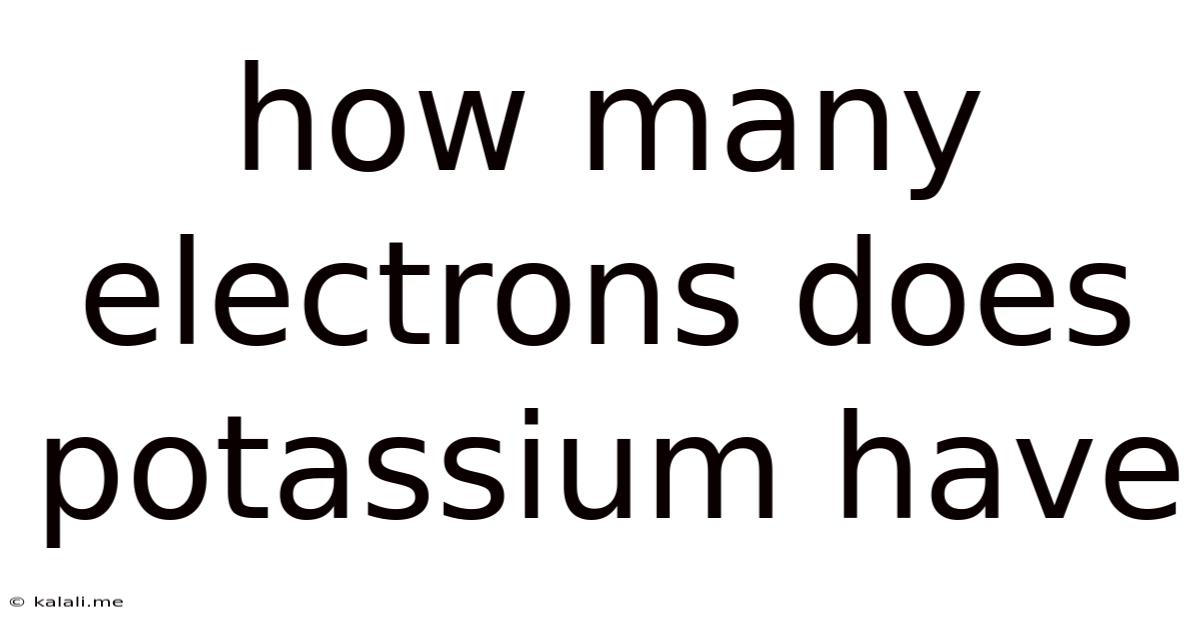How Many Electrons Does Potassium Have
Kalali
Jun 11, 2025 · 3 min read

Table of Contents
How Many Electrons Does Potassium Have? A Deep Dive into Atomic Structure
Potassium, a vital element for human health and a common component in fertilizers, holds a fascinating place in the periodic table. Understanding its atomic structure, particularly the number of electrons it possesses, is key to grasping its chemical properties and biological roles. This article will explore the electron configuration of potassium, explaining how to determine its electron count and its significance in chemistry.
Potassium's atomic number, which dictates the number of protons and electrons in a neutral atom, is 19. This means that a neutral potassium atom has 19 electrons. This is a crucial piece of information for understanding its reactivity and placement in the periodic table.
Understanding Atomic Structure and Electron Configuration
To truly understand why potassium has 19 electrons, let's delve into the basics of atomic structure. Atoms consist of a nucleus containing protons (positively charged) and neutrons (neutral charge), surrounded by orbiting electrons (negatively charged). The number of protons defines the element, while the number of electrons determines its chemical behavior. In a neutral atom, the number of protons and electrons are equal.
Electrons occupy specific energy levels or shells around the nucleus. These shells are labeled with numbers (1, 2, 3, etc.), with each shell having a maximum number of electrons it can hold. The first shell can hold up to 2 electrons, the second shell up to 8, the third up to 18, and so on. The electron configuration describes how electrons are distributed among these shells.
Potassium's Electron Configuration
Potassium's electron configuration is 1s²2s²2p⁶3s²3p⁶4s¹. Let's break this down:
- 1s²: The first shell (n=1) contains 2 electrons in the s orbital.
- 2s²2p⁶: The second shell (n=2) contains 2 electrons in the s orbital and 6 electrons in the p orbital, for a total of 8 electrons.
- 3s²3p⁶: The third shell (n=3) contains 2 electrons in the s orbital and 6 electrons in the p orbital, for a total of 8 electrons.
- 4s¹: The fourth shell (n=4) contains 1 electron in the s orbital.
Adding up the electrons in each shell (2 + 8 + 8 + 1), we arrive at a total of 19 electrons, confirming our initial statement.
Significance of Potassium's Electron Configuration
The outermost electron in potassium's 4s orbital is relatively loosely bound to the nucleus. This makes potassium highly reactive, readily losing this single electron to form a +1 ion (K⁺). This characteristic is crucial for its role in various biological processes, including nerve impulse transmission and muscle contraction. The ease with which potassium loses an electron is directly related to its electron configuration and the relatively large distance of the outermost electron from the nucleus.
Conclusion
In summary, a neutral potassium atom possesses 19 electrons, a number dictated by its atomic number. This electron configuration, with its single loosely bound electron in the outermost shell, explains its high reactivity and crucial biological functions. Understanding the atomic structure and electron configuration of elements like potassium is fundamental to comprehending their chemical behavior and their role in the natural world.
Latest Posts
Latest Posts
-
How Old Are You If You Were Born In 2002
Jul 01, 2025
-
How Many Sides Does A Star Have
Jul 01, 2025
-
How Many Ears Of Corn In A Can
Jul 01, 2025
-
What Grade Is A 15 Out Of 20
Jul 01, 2025
-
What Determines The Direction A Pwc Will Travel
Jul 01, 2025
Related Post
Thank you for visiting our website which covers about How Many Electrons Does Potassium Have . We hope the information provided has been useful to you. Feel free to contact us if you have any questions or need further assistance. See you next time and don't miss to bookmark.